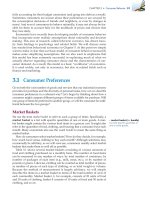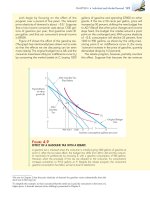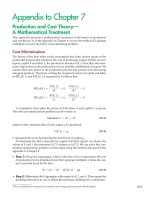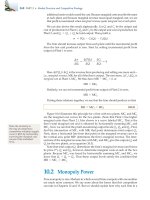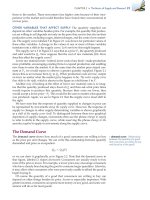(8th edition) (the pearson series in economics) robert pindyck, daniel rubinfeld microecon 128
Bạn đang xem bản rút gọn của tài liệu. Xem và tải ngay bản đầy đủ của tài liệu tại đây (98.45 KB, 1 trang )
CHAPTER 3 • Consumer Behavior 103
This result holds generally. Why? Because the Laspeyres price index assumes that
consumers do not alter their consumption patterns as prices change. By changing consumption, however—increasing purchases of items that have become relatively
cheaper and decreasing purchases of relatively more expensive items—consumers can achieve the same level of utility without having to consume the same
bundle of goods that they did before the price change.
Paasche Index
Another commonly used cost-of-living index is the Paasche index. Unlike the
Laspeyres index, which focuses on the cost of buying a base-year bundle, the
Paasche index focuses on the cost of buying the current year’s bundle. In particular, the Paasche index answers another question: What is the amount of money
at current-year prices that an individual requires to purchase the current bundle of
goods and services divided by the cost of purchasing the same bundle in the base year?
• Paasche index Amount of
money at current-year prices
that an individual requires to
purchase a current bundle of
goods and services divided by
the cost of purchasing the same
bundle in a base year.
COMPARING THE LASPEYRES AND PAASCHE INDEXES It is helpful to
compare the Laspeyres and the Paasche cost-of-living indexes.
• Laspeyres index: The amount of money at current-year prices that an individual requires to purchase the bundle of goods and services that was chosen in the
base year divided by the cost of purchasing the same bundle at base-year prices.
• Paasche index: The amount of money at current-year prices that an individual requires to purchase the bundle of goods and services chosen in the current
year divided by the cost of purchasing the same bundle in the base year.
Both the Laspeyres (LI) and Paasche (PI) indexes are fixed-weight indexes:
The quantities of the various goods and services in each index remain unchanged.
For the Laspeyres index, however, the quantities remain unchanged at base-year
levels; for the Paasche they remain unchanged at current-year levels. Suppose
generally that there are two goods, food (F) and clothing (C). Let:
PFt and PCt be current-year prices
PFb and PCb be base-year prices
Ft and Ct be current-year quantities
Fb and Cb be base-year quantities
We can write the two indexes as:
LI =
PFtFb + PCtC b
PFbFb + PCbC b
PI =
PFtFt + PCtC t
PFbFt + PCbC t
Just as the Laspeyres index will overstate the ideal cost of living, the Paasche
will understate it because it assumes that the individual will buy the current-year
bundle in the base period. In actuality, facing base-year prices, consumers would
have been able to achieve the same level of utility at a lower cost by changing
their consumption bundles. Because the Paasche index is a ratio of the cost of
• fixed-weight index
Cost-of-living index in which the
quantities of goods and services
remain unchanged.

